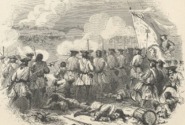CANADA HISTORY
Treaty of Ryswick

The Treaty of Ryswick, signed in 1697, was a significant milestone in both European and North American history, marking the end of the Nine Years' War between France and the Grand Alliance, which included Spain, England, and Holland. This treaty not only reshaped the balance of power in Europe but also had profound consequences for the colonial territories in North America. The cessation of hostilities between the French and their Algonquin allies on one side, and the English and the Iroquois Confederacy on the other, helped temporarily stabilize the region. However, the treaty also set the stage for future conflicts by returning the strategically important region of Nova Scotia to France, reinforcing French power in the continent through the fortress of Louisbourg.
In North America, the conflict that the Treaty of Ryswick brought to a close was part of what became known as King William’s War (1688–1697), the North American extension of the broader European conflict. King William’s War marked the first in a series of colonial wars between France and England that would span the next several decades. The war pitted French forces and their Algonquin allies against English settlers, who were supported by the powerful Iroquois Confederacy. These battles, which took place across the Atlantic seaboard and in the frontier regions of New York and New England, were characterized by brutal raids, with Indigenous groups playing a key role in both French and English strategies.
The Treaty of Ryswick, however, did not bring immediate peace to North America. Due to the slower pace of communications across the Atlantic, news of the treaty did not reach the colonies until two months after it had been signed in Europe. In the interim, fighting continued, with neither side aware that peace had already been declared. This delay in communication exemplifies the unique challenges faced by colonial powers in governing and coordinating with their distant possessions, especially in a time when sailing ships were the only means of delivering news and military orders.
One of the most significant aspects of the Treaty of Ryswick for North America was the return of Nova Scotia to French control. Nova Scotia, or Acadia as it was known to the French, had been a contested territory during the war. English forces had successfully captured the region, including the strategic outpost of Port Royal, in 1690. For several years, the English held control over this valuable maritime colony, which was vital for controlling the shipping lanes and fishing grounds of the North Atlantic.
The return of Nova Scotia to France under the terms of the treaty was a significant diplomatic victory for the French. Although the English had hoped to retain this territory, France’s regaining of control over Acadia ensured that they could continue to assert influence over the Gulf of St. Lawrence and the broader maritime region. This also provided the French with a crucial foothold in North America, allowing them to maintain access to the fur trade and defend their claims against English expansion.
Central to France's defense of its North American empire following the Treaty of Ryswick was the construction and fortification of Louisbourg. Located on Cape Breton Island, Louisbourg was to become the cornerstone of French power in the region. The fortress served multiple purposes: it protected France’s fishing and trade interests in the Atlantic, served as a military stronghold against potential English incursions, and provided a vital base for French naval operations. Louisbourg would eventually become one of the most formidable fortresses in North America, designed to withstand naval sieges and provide refuge for French ships. Its strategic significance would make it the focal point of future conflicts between France and Britain, particularly during the War of the Austrian Succession and the Seven Years’ War.
The return of Nova Scotia to France under the Treaty of Ryswick also had important consequences for the Indigenous peoples of the region, particularly the Mi’kmaq and other Algonquin-speaking groups allied with the French. French presence in Acadia and their strong alliances with these Indigenous nations helped France maintain its influence in the region and provided a counterweight to the English colonists, who were expanding steadily into native lands. The Mi’kmaq, for instance, played a vital role in resisting English expansion and maintaining French control over key areas of Nova Scotia.
For the English, the Treaty of Ryswick was a mixed outcome. While it ended the costly and destructive war in the colonies, it also meant that they would have to wait for another opportunity to challenge French dominance in the region. The Iroquois Confederacy, which had allied with the English during King William’s War, had suffered heavy losses during the conflict and was not included in the treaty’s negotiations. This exclusion would fuel resentment and strain the Iroquois' relationship with their English allies in the years to come. Furthermore, the failure to secure Nova Scotia as a permanent English colony meant that New Englanders remained vulnerable to French and Indigenous raids, particularly as Louisbourg began to grow in strength and influence.
Despite the cessation of direct conflict, the Treaty of Ryswick did little to resolve the underlying tensions between French and English colonial interests in North America. The war had been fought largely over control of key territories and trade routes, and those issues remained unresolved. Both France and England continued to see the vast lands of the continent as vital to their imperial ambitions. For the French, maintaining control of the St. Lawrence River and its surrounding territories was essential for their fur trade and for linking their settlements along the Great Lakes and the Mississippi River. For the English, the expanding population of the New England colonies created pressure to push further inland, threatening French territories and alliances with Indigenous nations.
The treaty also failed to address the deep divisions between Indigenous nations and European settlers. The Iroquois, who had fought alongside the English, continued to face pressure from both English and French settlers, as well as rival Indigenous groups aligned with the French. Meanwhile, the French relied on their alliances with Algonquin-speaking peoples to maintain their dominance in the fur trade and to counter English encroachment. These complex alliances would continue to shape the political landscape of North America for decades.
In the broader context of Canadian history, the Treaty of Ryswick and its aftermath highlight the fragile balance of power in early colonial North America. While it temporarily halted hostilities, it did not address the root causes of the conflict between France and England, nor did it provide a lasting resolution to their competing claims over the continent. The return of Nova Scotia to France and the construction of Louisbourg reinforced French power, but it also ensured that the region would remain a contested battleground in the future.
Ultimately, the Treaty of Ryswick set the stage for future conflicts between France and England, conflicts that would culminate in the decisive Seven Years’ War (1756–1763), which would finally resolve the struggle for control of North America in favor of the British. However, in the decades leading up to that war, the Treaty of Ryswick played a crucial role in shaping the political, military, and economic landscape of what would become Canada. By reinforcing French control over key territories and allowing for the development of Louisbourg, the treaty ensured that New France would continue to play a central role in the colonial contest for North America, even as the seeds of future conflicts were sown.
Cite Article : www.canadahistory.com/sections/documents




